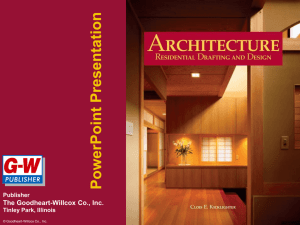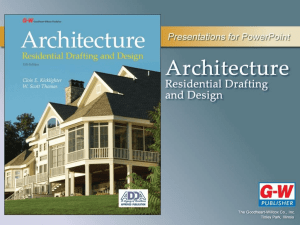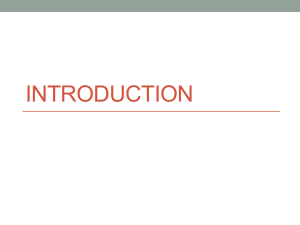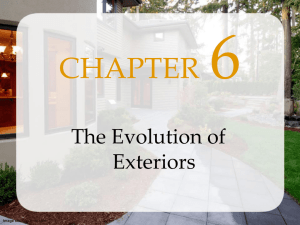Floor Framing
advertisement
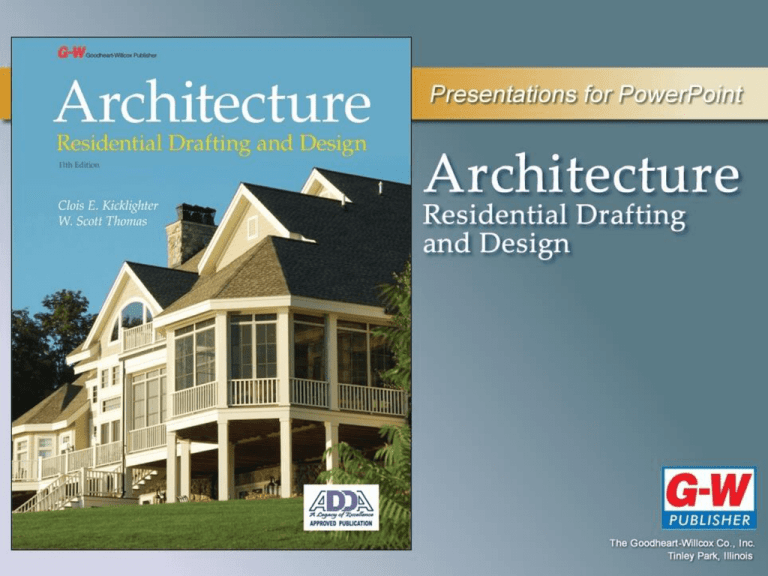
Chapter 18 Sill and Floor Construction Objectives • Describe the components of a floor system. • Explain the difference between platform and balloon framing. • Determine proper joist sizes using a typical span data chart. • Plan the appropriate floor support using joists or trusses for a structure. © Goodheart-Willcox Co., Inc. Permission granted to reproduce for educational use only. Objectives • Select the appropriate engineered wood products for specific applications in residential construction. • Explain the principles of post and beam construction. © Goodheart-Willcox Co., Inc. Permission granted to reproduce for educational use only. Introduction • Framing methods vary from one section of the country to another • Two basic types of floor framing are platform framing and balloon framing – Use plates, joists, and studs • Post and beam construction is used for walls and floors © Goodheart-Willcox Co., Inc. Permission granted to reproduce for educational use only. Platform Framing • Floor joists form a platform on which walls rest – Another platform rests on top of walls when there is a second story • Advantages include: – easy and fast to construct – shrinkage is uniform – platform provides a fire-stop between floors © Goodheart-Willcox Co., Inc. Permission granted to reproduce for educational use only. Platform Framing • The sill is starting point in constructing a floor – – – – – Lowest member of structure’s frame Rests on foundation and Supports floor joists or studs Generally 2 x 6 lumber Box sill construction generally used in platform framing © Goodheart-Willcox Co., Inc. Permission granted to reproduce for educational use only. Platform Framing • Box sill construction. © Goodheart-Willcox Co., Inc. Permission granted to reproduce for educational use only. Platform Framing • Box sill construction • Detail of first and second floor © Goodheart-Willcox Co., Inc. Permission granted to reproduce for educational use only. Balloon Framing • Wall studs rest directly on the sill plate • Each floor “hangs” from the studs • Advantages: small potential shrinkage, good vertical stability • Disadvantages: less safe work surface, need to add fire-stops • Two types of sill construction used: solid (standard) or T-sill © Goodheart-Willcox Co., Inc. Permission granted to reproduce for educational use only. Balloon Framing • Solid (standard) sill construction • Studs nailed directly to sill and joists • No header used © Goodheart-Willcox Co., Inc. Permission granted to reproduce for educational use only. Balloon Framing • • • • • T-sill construction Header rests on sill Serves as firestop Studs rest on sill Nailed to header and to sill plate © Goodheart-Willcox Co., Inc. Permission granted to reproduce for educational use only. Balloon Framing • First and second floor construction • Joists supported by a ribbon and nailed to studs on second floor level © Goodheart-Willcox Co., Inc. Permission granted to reproduce for educational use only. Joists and Beams • Joists provide support for floor • Usually made from Southern yellow pine, fir, larch, hemlock, or spruce • Engineered wood and metal joists are also available • Floor joists range in size from 2 x 6 to 2 x 12 © Goodheart-Willcox Co., Inc. Permission granted to reproduce for educational use only. Joists • Size based on span, load, species and grade of wood, and joist spacing – When using metal joists, consider gauge of metal instead of species and grade of lumber • Spaced 12", 16", or 24" on center © Goodheart-Willcox Co., Inc. Permission granted to reproduce for educational use only. Using a Span Data Table • • • • Select species of wood to be used Select appropriate live load Determine lumber grade to be used Scan the lumber grade row and note maximum spans • Select joist size and spacing that will support desired live load; 16" OC spacing is typical © Goodheart-Willcox Co., Inc. Permission granted to reproduce for educational use only. Span Data Example • • • • Span is 14'-0" Using number one dense southern pine Live load is 30 pounds per square foot Chart shows following choices: – 2 x 8 joists 12" OC or 16" OC – 2 x 10 joists 12" OC, 16" OC, or 24" OC – 2 x 12 joists 12" OC, 16" OC, or 24" OC • Best selection: 2 x 8 joists, 16" OC, will span up to 14'-5" © Goodheart-Willcox Co., Inc. Permission granted to reproduce for educational use only. Steel Floor Joists • Depths typically 6" to 12" • Thicknesses from 0.034" to 0.101" • Common spacing 24" OC, but other spacing also used © Goodheart-Willcox Co., Inc. Permission granted to reproduce for educational use only. Beams • When span is too great for unsupported joists, a beam or load-bearing wall is needed to reduce span • Beam can be solid timber, built-up, or metal S- or W-beam • Load-bearing walls may be concrete block, cast concrete, or frame construction © Goodheart-Willcox Co., Inc. Permission granted to reproduce for educational use only. Supporting Floor Joists with Beams © Goodheart-Willcox Co., Inc. Permission granted to reproduce for educational use only. Supporting Partition Walls • Partition walls that run parallel to floor joists require added support. © Goodheart-Willcox Co., Inc. Permission granted to reproduce for educational use only. Openings in Floor • Openings in the floor for stairs and chimneys required double joist framing. © Goodheart-Willcox Co., Inc. Permission granted to reproduce for educational use only. Cross Bridging • Cross bridging stiffens floor and spreads load over broader area • Bridging boards or metal bridging are used © Goodheart-Willcox Co., Inc. Permission granted to reproduce for educational use only. Green Architecture • Engineered floor joists – Sustainable alternative to solid wood joists – Can be made from wood chips and other wood products formerly considered waste – Stronger and can span longer distances than solid wood joists – Fewer joists needed to meet building codes © Goodheart-Willcox Co., Inc. Permission granted to reproduce for educational use only. Floor Trusses • Floor trusses have rigid framework designed to support a load over a span • Often used in place of floor joists in residential construction • Consist of top chord, bottom chord, and web – Chords are horizontal flanges on top and bottom of truss – Web is truss framework © Goodheart-Willcox Co., Inc. Permission granted to reproduce for educational use only. Engineered Floor Trusses • Designed using computers • Usually fabricated from 2 x 4 or 2 x 6 lumber and spaced 24" OC • Has built-in camber • Stress-graded lumber used in construction to reduce material • Webs may be metal or wood © Goodheart-Willcox Co., Inc. Permission granted to reproduce for educational use only. Subfloor • Subfloor affixed to top of floor joists – Glued or nailed to joists • Provides surface for underlayment • Made from plywood, tongue-and-groove boards, common boards, and other panel products © Goodheart-Willcox Co., Inc. Permission granted to reproduce for educational use only. Installing Subfloor Panels • Joist spacing must be accurate • All panel edges must be supported © Goodheart-Willcox Co., Inc. Permission granted to reproduce for educational use only. Cantilevered (Overhanging ) Joists • Section of floor that projects beyond a lower level called cantilever or overhang • When floor joists run perpendicular to cantilevered section, longer joists form cantilever • When joists are parallel to overhanging area, cantilevered joists are required © Goodheart-Willcox Co., Inc. Permission granted to reproduce for educational use only. Cantilevered Joists • Generally, joists should extend inside the structure twice the distance they overhang. © Goodheart-Willcox Co., Inc. Permission granted to reproduce for educational use only. Framing Under Slate or Tile • Requires substantial base • Concrete base needs lowered floor framing • Use smaller size joists, reduce space between joists • Use beams under section to support added weight • Use cement mortar mix © Goodheart-Willcox Co., Inc. Permission granted to reproduce for educational use only. Employability • Respecting diversity – Characteristics that vary from person to person is known as diversity – Being able to work with a diverse group is an important job skill – Getting to know those who differ from us makes us less likely to subject others to generalizations or preconceived biases we may have © Goodheart-Willcox Co., Inc. Permission granted to reproduce for educational use only. Engineered Wood Products • Engineered wood products (EWPs) combine wood veneers and fibers with adhesives to form beams, headers, joists, and panels • Include: – – – – – oriented strand board (OSB) parallel strand lumber (PSL) laminated veneer lumber (LVL) glue-laminated lumber wood I-joists © Goodheart-Willcox Co., Inc. Permission granted to reproduce for educational use only. Engineered Wood Products • Advantages: – – – – high quality and consistency no knots, checks, warps uniformly dried to 8% to 12% moisture content provides superior design flexibility • Disadvantage: – lack of industry standards © Goodheart-Willcox Co., Inc. Permission granted to reproduce for educational use only. Oriented Strand Board (OSB) • Made from long strands of wood and resin • Aspen is preferred wood • Advantages: – Less expensive than plywood – Unique appearance • Disadvantages: – Subject to swelling – Not designed for exposure to elements © Goodheart-Willcox Co., Inc. Permission granted to reproduce for educational use only. Oriented Strand Board (OSB) • • • • Made in panel sizes, typically 4' x 8' Available in sizes up to 8' x 24‘ 1/8" space along edges prevents buckling Use same nailing schedules used on plywood © Goodheart-Willcox Co., Inc. Permission granted to reproduce for educational use only. Parallel Strand Lumber (PSL) • • • • Made from thin strands of wood Used for beams, columns, headers High strength and span capacity Low-moisture content eliminates shrinking and checking • Large billets, 11" x 17“, formed and then sawed to specific sizes © Goodheart-Willcox Co., Inc. Permission granted to reproduce for educational use only. Parallel Strand Lumber (PSL) • Advantages: – Strong – Longer spans create more design flexibility • Disadvantages: – Engineered connections required for side-loading multiple-ply beam – Should not be drilled or notched – Stored according to manufacturer’s recommendations to prevent swelling © Goodheart-Willcox Co., Inc. Permission granted to reproduce for educational use only. Parallel Strand Lumber (PSL) • Widths from 1-3/4" to 7" • Two plies of 2-11/16" members match typical 51/2" wall • Lengths up to 66’ • Eliminates need for built-up beams © Goodheart-Willcox Co., Inc. Permission granted to reproduce for educational use only. Laminated Veneer Lumber (LVL) • Made from veneers stacked parallel to each other • Used for headers, beams, joists, columns, and flanges for wood I-beams • All plies parallel to provide maximum strength • Woods of choice are Southern yellow pine and Douglas fir © Goodheart-Willcox Co., Inc. Permission granted to reproduce for educational use only. Laminated Veneer Lumber (LVL) • Advantages: – High strength allows long spans – Can be built-up on site to form larger members • Disadvantages: – More expensive than solid lumber – Lower moisture content than solid lumber – Must be sized for specific load conditions © Goodheart-Willcox Co., Inc. Permission granted to reproduce for educational use only. Laminated Veneer Lumber (LVL) • 1-3/4“ billet most common • Use individually for joists or combined to form headers or beams • Available in depths from 5-1/2" to 14" and lengths up to 66‘ • Should not be mixed with solid lumber in the same floor assembly • Beams should not be drilled © Goodheart-Willcox Co., Inc. Permission granted to reproduce for educational use only. Glue-Laminated Lumber • Also called glulam beams • 1x or 2x lumber glued in stacks to desired shape and size – Virtually any length or depth can be produced • Manufactured to national standard • Grades available: framing, industrial, architectural, premium © Goodheart-Willcox Co., Inc. Permission granted to reproduce for educational use only. Glue-Laminated Lumber © Goodheart-Willcox Co., Inc. Permission granted to reproduce for educational use only. Glue-Laminated Lumber • Advantages: – high strength – available either straight or cambered – dimensionally stable and attractive • Disadvantages: – expensive – requires special handling and storage – requires special equipment to handle © Goodheart-Willcox Co., Inc. Permission granted to reproduce for educational use only. Installation of Glue-Laminated Lumber • Technical support generally required • Manufacturers provide span charts, installation details, technical assistance • Special connectors required © Goodheart-Willcox Co., Inc. Permission granted to reproduce for educational use only. Wood I-Joists • Generally made from 2 x 4 machined-stressed lumber or LVL • Webs usually made from 3/8" OSB • Available in variety of flange widths, depths, lengths © Goodheart-Willcox Co., Inc. Permission granted to reproduce for educational use only. Wood I-Joists • Advantages: – speed of construction – knockout holes for plumbing and electrical cable – dimensionally stable and straight • Disadvantages: – require more effort to cut – not universally accepted © Goodheart-Willcox Co., Inc. Permission granted to reproduce for educational use only. Wood I-Joists • Installation similar to traditional floor joists or rafters • Should not be mixed with solid lumber in same assembly • Web stiffeners or blocks normally used at bearing points © Goodheart-Willcox Co., Inc. Permission granted to reproduce for educational use only. Post and Beam Construction • Post and beam construction uses posts, beams, and planks as framing members • Spaced farther apart than conventional framing members • Posts carry most weight • Curtain walls allow for wide expanses of glass with no need for headers • Foundation is continuous wall or series of piers on which each post is located © Goodheart-Willcox Co., Inc. Permission granted to reproduce for educational use only. Post and Beam Construction • Check local codes for post size requirements • Beam types include solid, laminated, steelreinforced, plywood box • Spacing and span determined by size and type of materials and load to be supported • Beam placement systems include longitudinal method and transverse method © Goodheart-Willcox Co., Inc. Permission granted to reproduce for educational use only. Post and Beam Construction • Metal plates or connectors used to fasten posts and beams • Post and beam segments fastened with lag screws or bolts • Thickness of decking planks for roof and floor vary from 2" to 4“ • Roof decking span information listed in textbook © Goodheart-Willcox Co., Inc. Permission granted to reproduce for educational use only. Post and Beam Construction • Metal connectors © Goodheart-Willcox Co., Inc. Permission granted to reproduce for educational use only.
